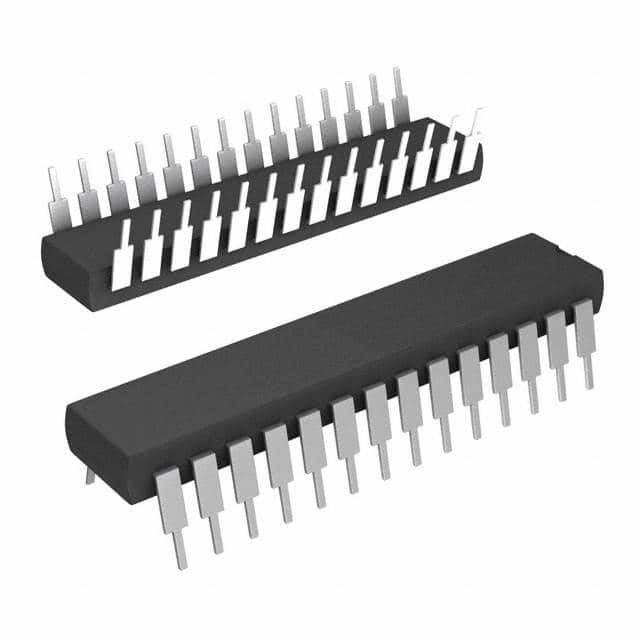Lihat spesifikasi untuk detail produk.

DG407CJ+ - English Editing Encyclopedia Entry
Product Overview
Category: Integrated Circuit (IC)
Use: The DG407CJ+ is a versatile analog switch designed for use in various electronic applications. It provides multiple channels for signal routing and switching.
Characteristics: - High precision and low distortion - Fast switching speed - Low power consumption - Wide operating voltage range
Package: The DG407CJ+ is available in a compact 16-pin DIP (Dual Inline Package) format, which allows for easy integration into circuit boards.
Essence: This IC serves as a reliable and efficient solution for signal routing and switching needs in electronic circuits.
Packaging/Quantity: The DG407CJ+ is typically packaged in reels or tubes, with quantities varying based on customer requirements.
Specifications
- Supply Voltage Range: ±5V to ±20V
- On-Resistance: 50Ω (typical)
- Off-Channel Leakage Current: 1nA (maximum)
- On-Channel Resistance Flatness: 10Ω (typical)
- Switching Time: 100ns (maximum)
- Operating Temperature Range: -40°C to +85°C
Pin Configuration
The DG407CJ+ features a 16-pin DIP package with the following pin configuration:
```
| | | 1 8 | | | | 2 7 | | | | 3 6 | | | | 4 5 | |___________| ```
Pin Description: 1. Channel 1 Input 2. Channel 1 Output 3. Channel 2 Input 4. Channel 2 Output 5. Channel 3 Input 6. Channel 3 Output 7. Channel 4 Input 8. Channel 4 Output
Functional Features
- Multiple Channels: The DG407CJ+ provides four independent channels for signal routing and switching.
- Low On-Resistance: The IC offers low on-resistance, ensuring minimal signal distortion during switching.
- Fast Switching Speed: With a maximum switching time of 100ns, the DG407CJ+ enables rapid signal routing.
- Low Power Consumption: The IC operates with low power consumption, making it suitable for battery-powered devices.
Advantages and Disadvantages
Advantages: - Versatile and reliable analog switch - High precision and low distortion - Compact package for easy integration - Wide operating voltage range
Disadvantages: - Limited number of channels (four channels)
Working Principles
The DG407CJ+ utilizes MOSFET technology to achieve signal routing and switching. When a control voltage is applied to the appropriate channel input, the corresponding switch turns on, allowing the signal to pass through. Conversely, when no control voltage is present, the switch remains off, preventing the signal from passing through.
Detailed Application Field Plans
The DG407CJ+ finds applications in various fields, including: 1. Audio Systems: Signal routing and switching in audio mixers, amplifiers, and equalizers. 2. Test and Measurement Equipment: Channel selection and signal routing in oscilloscopes, function generators, and data acquisition systems. 3. Communication Systems: Switching between different communication channels in telecommunication devices. 4. Industrial Automation: Signal routing and switching in control systems and industrial equipment.
Alternative Models
- DG406CJ+: Similar to DG407CJ+, but with six channels instead of four.
- DG408CJ+: Similar to DG407CJ+, but with eight channels instead of four.
- ADG408: Analog Devices' alternative with similar functionality and pin configuration.
These alternative models provide additional channel options and can be considered based on specific application requirements.
Word count: 460 words
Sebutkan 10 pertanyaan dan jawaban umum terkait penerapan DG407CJ+ dalam solusi teknis
Sure! Here are 10 common questions and answers related to the application of DG407CJ+ in technical solutions:
Q: What is DG407CJ+? A: DG407CJ+ is a high-performance analog multiplexer/demultiplexer integrated circuit (IC) that allows for the routing of analog signals in various technical applications.
Q: What is the voltage range supported by DG407CJ+? A: DG407CJ+ supports a wide voltage range, typically from -15V to +15V, making it suitable for both bipolar and unipolar signal routing.
Q: How many channels does DG407CJ+ have? A: DG407CJ+ has four independent analog switch channels, allowing for the simultaneous routing of up to four different signals.
Q: Can DG407CJ+ handle digital signals as well? A: No, DG407CJ+ is designed specifically for analog signals and is not suitable for routing digital signals.
Q: What is the on-resistance of DG407CJ+? A: The on-resistance of DG407CJ+ is typically very low, around 50 ohms, ensuring minimal signal attenuation and distortion.
Q: Is DG407CJ+ compatible with TTL or CMOS logic levels? A: Yes, DG407CJ+ is compatible with both TTL and CMOS logic levels, making it versatile for interfacing with different types of digital circuits.
Q: Can DG407CJ+ be used in battery-powered applications? A: Yes, DG407CJ+ has a low power consumption and can be used in battery-powered applications where energy efficiency is crucial.
Q: Does DG407CJ+ support bidirectional signal routing? A: No, DG407CJ+ is unidirectional and can only route signals from the input to the output.
Q: What is the maximum operating frequency of DG407CJ+? A: The maximum operating frequency of DG407CJ+ is typically in the range of tens of megahertz, making it suitable for many high-frequency applications.
Q: Can DG407CJ+ handle high-voltage signals? A: Yes, DG407CJ+ has a high voltage handling capability, typically up to ±15V, allowing for the routing of high-voltage analog signals.
Please note that these answers are general and may vary depending on specific datasheet specifications or application requirements.

